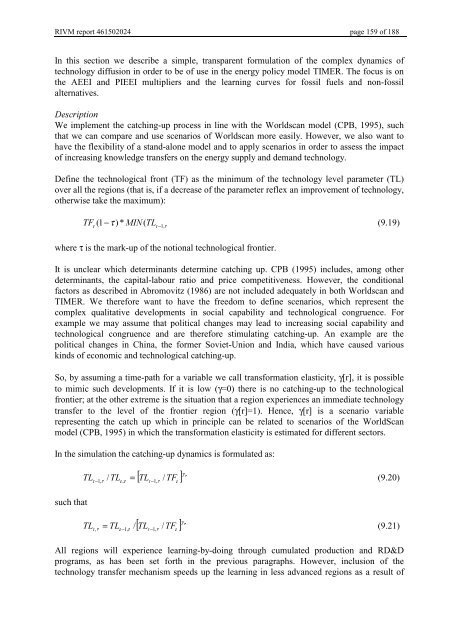Targets IMage Energy Regional (TIMER) Model, Technical ...
Targets IMage Energy Regional (TIMER) Model, Technical ...
Targets IMage Energy Regional (TIMER) Model, Technical ...
You also want an ePaper? Increase the reach of your titles
YUMPU automatically turns print PDFs into web optimized ePapers that Google loves.
RIVM report 461502024 page 159 of 188<br />
In this section we describe a simple, transparent formulation of the complex dynamics of<br />
technology diffusion in order to be of use in the energy policy model <strong>TIMER</strong>. The focus is on<br />
the AEEI and PIEEI multipliers and the learning curves for fossil fuels and non-fossil<br />
alternatives.<br />
'HVFULSWLRQ<br />
We implement the catching-up process in line with the Worldscan model (CPB, 1995), such<br />
that we can compare and use scenarios of Worldscan more easily. However, we also want to<br />
have the flexibility of a stand-alone model and to apply scenarios in order to assess the impact<br />
of increasing knowledge transfers on the energy supply and demand technology.<br />
Define the technological front (TF) as the minimum of the technology level parameter (TL)<br />
over all the regions (that is, if a decrease of the parameter reflex an improvement of technology,<br />
otherwise take the maximum):<br />
7) ( 1−τ ) * 0,1(<br />
W<br />
7/W −1,<br />
(9.19)<br />
U<br />
where τ is the mark-up of the notional technological frontier.<br />
It is unclear which determinants determine catching up. CPB (1995) includes, among other<br />
determinants, the capital-labour ratio and price competitiveness. However, the conditional<br />
factors as described in Abromovitz (1986) are not included adequately in both Worldscan and<br />
<strong>TIMER</strong>. We therefore want to have the freedom to define scenarios, which represent the<br />
complex qualitative developments in social capability and technological congruence. For<br />
example we may assume that political changes may lead to increasing social capability and<br />
technological congruence and are therefore stimulating catching-up. An example are the<br />
political changes in China, the former Soviet-Union and India, which have caused various<br />
kinds of economic and technological catching-up.<br />
So, by assuming a time-path for a variable we call transformation elasticity, γ[r], it is possible<br />
to mimic such developments. If it is low (γ=0) there is no catching-up to the technological<br />
frontier; at the other extreme is the situation that a region experiences an immediate technology<br />
transfer to the level of the frontier region (γ[r]=1). Hence, γ[r] is a scenario variable<br />
representing the catch up which in principle can be related to scenarios of the WorldScan<br />
model (CPB, 1995) in which the transformation elasticity is estimated for different sectors.<br />
In the simulation the catching-up dynamics is formulated as:<br />
such that<br />
[ ]<br />
γ<br />
U<br />
7/ /<br />
7/<br />
7)<br />
W<br />
7/<br />
− 1,<br />
/ 7/<br />
U<br />
W,<br />
=<br />
U<br />
W−1,<br />
(9.20)<br />
U<br />
W<br />
[ ]<br />
γ<br />
U<br />
7/ /<br />
W, U<br />
7/<br />
W−1,<br />
U<br />
/<br />
W−1,<br />
U<br />
7)<br />
W<br />
= (9.21)<br />
All regions will experience learning-by-doing through cumulated production and RD&D<br />
programs, as has been set forth in the previous paragraphs. However, inclusion of the<br />
technology transfer mechanism speeds up the learning in less advanced regions as a result of
















